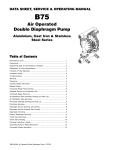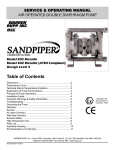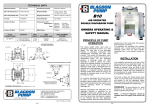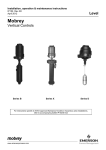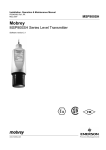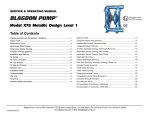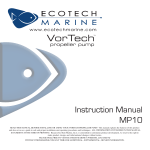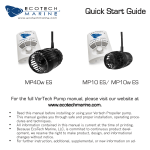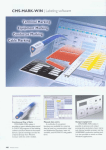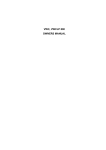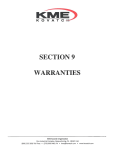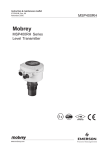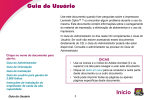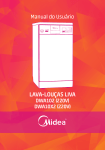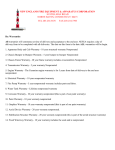Download PDF
Transcript
SERVICE & OPERATING MANUAL AIR OPERATED DOUBLE DIAPHRAGM PUMP B25 & X25 Hygienic Series Inc. Lube Free Models This pump is Atex approved for use in potentially explosive atmospheres Group II category 2 Table of Contents Service / Maintenance Log, Recycling 2 Dimensions 3 Performance Curve 3 Technical Data & Temperature limitations 4 Explanation of Pump Nomenclature 4 Principle of Pump Operation 5 Installation guide 5 Important Warnings & Safety Information 6 Troubleshooting 7 Grounding the Pump 7 Warranty 8 Service 8 Air Valve Overhaul 8 Wet-side Overhaul 8 Exhaust Safety 9 Parts List 10 Assembly Drawing 11 Declaration of Conformity 12 II 2 GD c 31783 HG-CF-921 Rev. L - 28.07.05 57470 Page 1 Service / Maintenance Log Date Details Completed RECYCLING Many components of BLAGDON air operated double diaphragm pumps are made of recyclable materials. We encourage pump users to recycle worn out parts and pumps whenever possible, after any hazardous pumped fluids are thoroughly flushed. Contact Information Contact HG-CF-921 Rev. L - 28.07.05 Phone / Fax No. Page 2 GA Drawing & Performance Curve General Assembly :- B25 / X25 Hygienic Models, all dimensions +/- 2mm B25 / X25 Hygienic Performance Curve Performance based on water at ambient temperature HG-CF-921 Rev. L - 28.07.05 Page 3 TECHNICAL DATA FLUID CONNECTIONS CAPACITY MAX SOLIDS MAX DISCHARGE HEAD DISPLACEMENT/STROKE 1” RJT Male 0 - 136 Litres/Minute (0 - 30 Gallons/Minute) 5 MM (3/16”) 88 Meters (289 ft) 0.5 Litres (0.11 UK Gallons) MAX. WORKING PRESSURE AIR INLET TEMPERATURE LIMITS PUMP WEIGHTS :- 8.6 Bar (125 psi) 3/8” BSP (F) Determined by Elastomers 21.5 Kg Operating Temperatures Maximum Materials EPDM - Shows very good water and chemical resistance. Has poor resistance to oils and solvents, but is fair on ketones and alcohols. Virgin PTFE - Chemically inert, virtually impervious. Very few chemicals are known to react chemically with PTFE : molten alkali metals, turbulent liquid or gaseous fluorine and a few fluoro-chemicals such as chlorine trifluoride or oxygen difluoride which readily liberate free fluorine at elevated temperatures. • • • • Gentle pumping action to avoid damage to food and beverage products. Range of RJT/DIN/FERRULE connections. Self priming for emptying containers. Food grade elastomers – EPDM/PTFE TYPICAL CODE = • • • • • Minimum o o Optimum 212 F 100oC -11 F -24oC 50o to 212oF 10o to 100oC 356oF 180oC 32oF 0oC 50o to 212oF 10o to 100oC Pressures to 8.6 bar. Capable of handling high viscosity & SG fluids. Certified CIP cleanable. EU Design approval 316L Stainless Steel 25.Z F. B B. E E E - L F MODEL 25 : STANDARD X25 : ATEX CAT. 2 LUBE FREE VALVE SEATS WETTED COMPONENTS Z : 316L STAINLESS STEEL E : EPDM (FOOD GRADE) S : STAINLESS STEEL (POLISHED) NON - WETTED COMPONENTS F : NICKEL PLATED ALUMINIUM VALVE BALLS S: 316L STAINLESS STEEL E : FOOD GRADE EPDM T : PTFE S : 316 STAINLESS STEEL VALVE TYPE B : BALL DIAPHRAGMS SUCTION ORIENTATION B : BOTTOM E : EPDM (FOOD GRADE) O : ONE PIECE PTFE IMPORTANT This pump should be used in accordance with the requirements of the Health and Safety at Work Act 1974. All business conducted subject to Blagdon Pump. Terms and Conditions of Sale, available on request. LAMBERT ROAD,ARMSTRONG, WASHINGTON, TYNE & WEAR NE37 1QP, ENGLAND. TEL. : 0044 (0) 191 4177475 FAX. : 0044 (0) 191 4175435 Web Site : www.blagdonpump.com E-Mail : [email protected] HG-CF-921 Rev. L - 28.07.05 Page 4 PRINCIPLE OF PUMP OPERATION This ball valve type diaphragm pump is powered by compressed air and is a 1:1 ratio design. The inner side of one diaphragm chamber is alternately pressurised while simultaneously exhausting the other inner chamber. This causes the diaphragms, which are connected by a common shaft secured by plates to the centres of the diaphragms, to move in a reciprocating action. (As one diaphragm performs a discharge stroke the other diaphragm is pulled to perform the suction stroke in the opposite chamber.) Air pressure is applied over the entire inner surface of the diaphragm while liquid is discharged from the opposite side of the diaphragm. The diaphragm operates in a balanced condition during the discharge stroke which allows the pump to be operated at discharge heads of over 200 feet (61 meters) of water. For maximum diaphragm life, keep the pump as close to the liquid being pumped as possible. Positive suction head in excess of 10 feet of liquid (3.048 meters) may require a back pressure regulating device to maximize diaphragm life. Alternate pressurising and exhausting of the diaphragm chamber is performed by an externally mounted, pilot operated, 2 way type distribution valve. When the spool shifts to one end of the valve block body, inlet pressure is applied to one chamber and the other diaphragm chamber exhausts. When the spool shifts to the opposite end of the valve body, the pressure to Lubricator Filter/Regulater the chambers is reversed. This alternating movement of the spool inside the valve body is controlled by a pilot air pressure signal held against the diaphragm shaft, between seals in the diaphragm shaft bushes. This signal is released, triggering the movement of the spool, when pilot holes in the diaphragm shaft align with the held pilot signal, sending the signal to exhaust, which in-turn causes a pressure imbalance around the spool, sending it to the opposite end of the valve body. This simultaneously sends inlet pressure to the opposite chamber. The chambers are connected by manifolds with a suction and discharge ball valve for each chamber, maintaining flow in one direction through the pump. INSTALLATION The typical installation shown in FIG. 1 is only a guide to selecting and installing system components. Your installation will depend on the type of fluid being pumped and your application needs. To reduce the risk of serious bodily injury and damage to property, never use fluids in this pump which are not compatible with the wetted components. Contact your local distributor or the manufacturer for system design assistance & compatibility if necessary. Mount the pump in an upright position. Failure to ensure an upright position may result in loss of or poor priming characteristics. Ensure the pump is securely mounted to avoid movement and possible risk of bodily injury. PRESSURE The pump delivers the same pressure at the discharge outlet as the air pressure applied at the air inlet (unless pump is configured as a 2:1 ratio model). NOTE: Pressure Regulator (H) should be installed where air supply could exceed 125 psi. SAFETY Your BLAGDON PUMP is a high performance unit capable of achieving high outputs at high efficiencies. However, as is common with pneumatic equipment, the pump efficiencies is reliant upon the air being clean, dry and filtered. Failure to comply with these requirements may lead to loss of performance and reduced component life and in extreme cases, permanent damage to the pump. To avoid leaks, ensure that all fluid connections are tight. The use of PTFE thread tape correctly applied should be used to ensure 100% leak proof connections. Failure to ensure 100% sealability of the suction connection could adversely affect suction performance. If you are pumping hazardous fluids, or operating the pump in an enclosed area, it is essential that the exhaust from the pump is piped away to a safe location. When pumping hazardous fluids the above instructions must be adhered to in order to ensure safe operating procedures. (Under certain operating conditions the failure of internal components can lead to the pumped fluid being exhausted via the pump exhaust outlet). WARNING NEVER place your hands over or near the pump suction inlet. Powerful suction could cause serious bodily injury. FLUSH THE PUMP This pump was tested with water containing an oil-based rust inhibitor. If this solution could contaminate or react with the fluid you are pumping, flush the pump thoroughly with a solvent/detergent to clean internal components. The solvent/ detergent must be compatible with the pump materials of construction. Care should be taken to flush the pump each time it is disassembled for maintenance or repair. CAUTION All BLAGDON PUMPS are Installation Guide Fig. 1 built lubricated with grease during assembly and need no further lubrication. If the use of oil cannot be avoided, this will not present any problems. A light No. 2 class lithium grease is recommended. Other grades may cause the Air Logic System to operate intermittently, thereby causing a loss of output and failure to operate. Other seals are available for “clean room” conditions If the pump accelerates or is running too fast due to a lack of fluid, then stop it immediately by shutting off the air supply. A dry pump will accelerate to a high speed causing wear to elastomers. If the fluid you are pumping tends to dry up or set when it is not moving, then flush the pump as often as necessary to prevent the fluid from drying in the pump. Drain the pump thoroughly before storing. If feasible, invert pump to allow any fluid to drain from the non-return valves. HG-CF-921 Rev. L - 28.07.05 Page 5 Important Warnings and Safety Information IMPORTANT Read these safety warnings and instructions in this manual completely, before installation and start-up of the pump. It is the responsibility of the purchaser to retain this manual for reference. This manual must be kept with, and supplied with the pump at all times. Failure to comply with the recommendations stated in this manual will damage the pump, and void factory warranty. These instructions are available if required, in the language or languages of the country or countries in which the equipment is used. Please refer to the manufacturer for details. IMPORTANT! This pump is pressurized internally with air pressure during operation. Always make certain that all bolting is in good condition and that all of the correct bolting is reinstalled during assembly. End-user must ensure correct fitting of Inlet / Outlet connections. Crossed threads or over tightening of connections will result in leaks. Quick action/release connections are not recommended. If their use is unavoidable, the levers must be locked to avoid them being forced apart in a hazardous manner. WARNING! Before maintenance or repair, shut off the compressed air line, bleed the pressure, and disconnect the air line from the pump. The discharge line may be pressurized and must be bled of its pressure. End-user must ensure correct regulation of air supply pressure, as any increase in air pressure results in a similar increase in product pressure if stalled-out. WARNING! Before doing any maintenance on the pump, be certain all pressure is completely vented from the pump, suction, discharge, piping, and all other openings and connections. Be certain the air supply is locked out or made non-operational, so that it cannot be started while work is being done on the pump. Be certain that approved eye protection and protective clothing are worn at all times in the vicinity of the pump. Failure to follow these recommendations may result in serious injury or death. WARNING! Airborne particles and loud noise hazards. Wear ear and eye protection. WARNING! Take action to prevent static sparking. Fire or explosion can result, especially when handling flammable liquids. The pump, piping, valves, containers or other miscellaneous equipment must be grounded. Refer to exhaust safety instructions on page 9. WARNING! When used for toxic or aggressive fluids, the pump should always be flushed clean prior to disassembly. User must ensure chemical compatibility, and any pressure / temperature limits are not exceeded. These instructions include all the information for relevant diaphragm temperature limits. Pump temperature range can also be found on data-plate attached to the pump. If pump is not used for more than 5 days, care must be taken when restarting. If in any doubt, remove pump from line and flush with a suitable cleaner. Solidified deposits within the pump may cause damage to the diaphragms. CAUTION! Before pump operation, inspect all gasketed fasteners for looseness caused by gasket creep. Re-torque loose fasteners to prevent leakage. Follow recommended torques stated in this manual. In cases of excess vibration, Blagdon recommend fitting a Pulsation Dampener to remove effects of pulse actions from pump operation. Flexible connections can be used, but must be kept to a minimum length necessary to avoid sharp flexing or straining movements. HG-CF-921 Rev. L - 28.07.05 Page 6 TROUBLE SHOOTING GUIDE NOTE :- Check all solutions before dismantling the pump. PROBLEM Pump will not start CAUSE Air valve assembly malfunction/Seizure Obstructed fluid line. Obstructed diaphragm chamber. Diaphragm failure causing fluid & excessive air to be expelled through the exhaust. Diaphragm seal failure. Air valve system malfunction. Air connected to exhaust. Erratic flow SOLUTION Check carrier for freedom of movement. Clean, oil & replace. Clean line or increase line size. Remove obstruction. Replace diaphragm. Replace shaft seals. Check all seals in valve chest assembly. Re-connect to air inlet. Diaphragm failure on one side. Valve ball not seating. Suction leakage. Diaphragm failure causing fluid & excessive air to be expelled through the exhaust. Diaphragm seal failure. Air valve system malfunction. Replace diaphragm. Check and remove obstruction. Check and correct. Replace diaphragm. Pump strokes but will not discharge Excessive suction lift. Suction line leakage. Valve ball not seating correctly or damaged. Suction line or strainer clogged. Diaphragm failure. Shorten suction line. Check and correct. Check and remove obstruction / replace. Clear. Replace diaphragm. Fluid discharged from air exhaust Diaphragm Failure. Loose frontplate. Replace diaphragm. Re-Torque to manual specifications. Intermittent stroke rate Over lubrication Shut-down pump. Remove air connection into pump & introduce a small quantity of degreasing agent into air valve and replace line. Run pump until clear. Replace seals. Check all seals in valve chest assembly. Clear obstruction. Diaphragm shaft seal failure. Air valve system malfunction. Valve ball not seating / partially obstructed. Replace shaft seals. Check all seals in valve chest assembly. ATEX Certified units :- X25 These models are certified to :- II 2 GD c Non-electrical equipment for potentially explosive atmospheres, : EN13463-1 : 2001 ‘c’ - Internal control of production. Grounding the pump :WARNING! Take action to prevent static sparking. Fire or explosion can result, especially when handling flammable liquids. The pump, piping, valves, containers or other miscellaneous equipment must be grounded. The Atex approved units are supplied with a natural earth ground cable. This cable is 2 meters in length and permanently connected through a nut and bolt at the inner cover casting. The other end is free to connect to the nearest available suitable point to provide a natural earth ground. This must be done to reduce the risk of electro-static sparking. HG-CF-921 Rev. L - 28.07.05 Page 7 IMPORTANT! Read these instructions completely, before installation and start-up. It is the responsibility of the purchaser to retain this manual for reference. Failure to comply with the recommendations stated in this manual will damage the pump, and void factory warranty. SERVICE The following sections give a general overview on how to service all models of BLAGDON Diaphragm Pumps. For details on individual part numbers, quantities, materials, etc., please consult the parts list supplied with the pump. NOTE : Before commencing any service or maintenance work on the pump, ensure that the air supply has been disconnected or isolated. AIR VALVE SYSTEMS PNEUMATIC TYPE Remove the 4 screws securing the valve block to the valve chest, together with any associated gaskets or seals. Remove slide valve plate & slide valve from the valve block assembly. Clean all parts thoroughly and inspect for excessive wear, replacing where necessary. The slide valve and valve plate contact faces should be flat and free from scratches. A light polishing on a flat surface with a fine abrasive paper will remove most scratches. re-torque in accordance to the settings shown in the parts list. In the event of a complete air-side overhaul, the pump should be disassembled down to the centre section assembly as described later in the “WetSide Overhaul” section. With the valve block assembly dismantled, remove the inner covers where appropriate. A careful note of the position of all related seals and gaskets should be made to facilitate re-assembly. Remove diaphragm shaft bushes, where appropriate, and check all seals and ‘O’ rings for wear or damage. If worn, replace immediately. NOTE:- The integrity of the diaphragm shaft seals is essential for the correct functioning of all pneumatically actuated valve systems. Check the diaphragm shaft for excessive wear as this will result in premature seal failure. Replace as required. Lubricate all components and re-assemble as detailed above, in reverse order. Ensure the correct position of all components detailed in all sectional assembly drawings. WET-SIDE OVERHAUL R E P L A C I N G B A L L VA L VE S Remove discharge manifold from pump assembly together with associated valve balls, seats and ‘O’ rings. NOTE :- The orientation of the valve seat relative to the valve ball should be noted as incorrect positioning may result in a performance loss. If excessive wear is suspected in the valve block bore or valve carrier, remove the valve block plugs and withdraw the valve carrier. Check valve block plug orings for wear or attack & replace where required. Turn pump through 180o and remove the suction manifold. Clean and inspect the components. Check for any wear or damage and replace as required. Clean the valve carrier & valve block bore with white spirits to remove any oil films. NOTE :- Ball or valve seat wear may result in loss of performance and suction lift. NOTE : The nominal diametrical clearance between the valve carrier and the valve block bore should be 0.05 0.09mm. A clearance in excess of this will cause the valve system to run erratically. Re-assemble the valve balls/seats and ensure manifolds are adequately torqued to the settings shown in the parts list. Apply a light grease to the valve block plug O-rings when re-assembling into the valve block bore. Any damage to the Oring may cause the valve system to malfunction. Re-assemble the valve block assembly & HG-CF-921 Rev. L - 28.07.05 REPLACING DIAPHRAGMS Remove both suction and discharge manifolds as detailed in the previous section, removing all ball valves, seats and ‘O’ rings. Loosen and remove both outer covers from the pump assembly. The orientation of the covers should be noted so as to facilitate re-assembly. Holding one of the frontplates in a vice, (‘soft jaws’ should be fitted), or with an adjustable spanner, loosen and remove the frontplate from the opposite end. Remove the diaphragm, backplate and bumpstop from diaphragm shaft. Carefully withdraw the diaphragm shaft from the centre section and hold the free end in a vice, holding between the flats machined on the end. Loosen and remove the frontplate and remove the diaphragm together with backplate and bumpstop (where fitted). NOTE :- Care should be taken with all plastic, coated and hygienic pumps, so that the surface of the frontplate is not damaged. Thoroughly clean all parts and check for wear, damage, swelling, cracking, delamination and chemical attack. Replace components where required. NOTE :- Rubber diaphragms should be replaced if they are worn to such an extent that the fabric re-enforcing is evident on the surface of the diaphragm. For pumps fitted with PTFE diaphragms, a light coating of grease should be applied to the back-up diaphragm prior to re-assembly. Before re-assembly, it is advisable to check the condition of the diaphragm shaft seal/’O’ rings for wear or attack. If either is evident, it is recommended that they be replaced. Assemble the diaphragms onto the shaft in a reverse sequence to their removal. Care should be taken as to the orientation of the diaphragm relative to the front and back plates. All diaphragms have “AIR SIDE” moulded onto one side. The backplate must be fitted adjacent to the AIR SIDE of the diaphragm. NOTE :- To achieve a leak free seal around the clamp bands a plastic mallet (A) should be used to gently tap the clamp band into position, in a circular manner. (Ref Fig. 2) The clamp (B) should be tightened simultaneously whilst using the mallet. On all pumps fitted with stainless steel fasteners, including clamp bands, it is recommended that anti-seizure paste is applied to the threads . Bolted assemblies should be torqued to the settings shown A in the parts list. The manifolds should be reassembled as described in the previous section. B Fig. 2 Page 8 EXHAUST SAFETY WHEN PUMPING HAZARDOUS LIQUIDS WARNING! In the event of diaphragm rupture, pumped material may enter the air end of the pump, and be discharged into the atmosphere. If pumping a product which is hazardous or toxic, the air exhaust must be piped to an appropriate area for safe disposition. Flooded Suction Installation Submerged Installation Suction Lift Installation Exhaust Safety :When a diaphragm fails during operation, pumped liquid can enter and contaminate the air side of the pump. If diaphragm failure is not severe, i.e. a small split or hole, then the pump can continue to run, with air being forced into the product being pumped. If however the failure is more serious, then the pump may stop, with fluid or fumes being expelled through the exhaust. Under these conditions it is recommended that the exhaust is piped away to a safe area. In standard suction lift conditions this can simply be done by piping from the exhaust connection to a safe area. Multiple installations can be piped to a common connection, then to a safe area. In flooded suction conditions the exhaust must be taken to a point higher than the fluid level to prevent any siphoning away. In submerged conditions ensure exhaust is piped away above fluid level. In all conditions ensure exhaust outlet is not expelling across a non-conductive surface. The exhaust must not be placed less than 100mm from any non-conductive surface, as this may generate a propagating brush discharge resulting in a possible ignition source. HG-CF-921 Rev. L - 28.07.05 Page 9 HG-CF-921 Rev. L - 28.07.05 PARTS LIST REF No. PART NUMBER 1 25-065 2 25-057 3 PARTS LIST - cont. QTY REF No. PART NUMBER PUMP STAND 1 37 40-215 VALVE BLOCK SUCTION MANIFOLD (see table for optional connections) 1 38 40-047 SILENCER (STANDARD MODELS ONLY) 1 25-064 CLAMP BAND 4 39 G431 O-RING (USED WITH ST. STEEL SEATS ONLY) 4 4 SEE TABLE VALVE SEAT 4 5 SEE TABLE VALVE BALL 6 25-056 7 SA10403 8 SEE TABLE 9 25-058 DISCHARGE MANIFOLD (see table for optional connections) 1 10 1A259 BACKPLATE 2 11 1A009 BUMP STOP 2 12 25-059 INNER COVER 13 G242 14 40-196 DESCRIPTION 4 38 1A377 2 40 SA10288 FRONTPLATE ASSY 2 41 2 42 O-RING 2 VALVE CHEST 2 1 15 25-060 DIAPHRAGM SHAFT 16 G367 O-RING 2 17 G245 O-RING 2 18 G189 O-RING 2 19 40-194 20 G514 SOCKET CAP SCREW 4 22 C173 SPRING WASHER 4 23 A040 BOLT 12 24 C044 WASHER 32 25 B469 NUT 16 26 A035 BOLT 4 G339 O-RING Page 10 D314 SOCKET CAP SCREW 29 G243 O-RING 2 30 40-204 GASKET 1 31 40-005 VALVE PLATE 32 40-004 SLIDE VALVE 33 H501 34 40-207 35 G512 36 40-192 VALVE BLOCK PLUG O-RING VALVE CARRIER 1 SP467 ATEX CAT.2 I/D TAG 1 SP473 TIE-LOK TIE 1 ELASTOMER TABLE REF No. DESCRIPTION FOOD GRADE EPDM PTFE STAINLESS STEEL QTY 4 VALVE SEAT 25-061 - 25-097 4 5 VALVE BALL 25-062 1A002 1A197 4 8 DIAPHRAGM 25-063 25-071 - 2 - These items are available in a recommended spares kit. Please refer to your local stockist / distributor for details. - These items are available in a recommended spares kit - SA10415 - Air side Kit Lube Free Air Side Kit :- SA10433 - These items are available as Sub-Assy. Spare :- SA10463 LUBE FREE COMPONENTS REF No. 20 DESCRIPTION LUBE FREE SEAL (CENTRE SECTION) CONNECTION TYPE 1” PTFE QTY 25-072 6 OPTIONAL MANIFOLD PART NUMBERS See distributors for details QTY SUCTION MANIFOLD DISCHARGE MANIFOLD DIN 25-112 25-113 1 FERRULE 25-115 25-116 1 IDF 25-067 25-068 1 8 28 CIRCLIP 1 GROUNDING LEAD ASSY. 6 D310 8 1 1 2 2 2 1 1 SILENCER 2 21 27 1 DIAPHRAGM SHAFT BUSH O-RING (See table for Lube Free Seal Option) QTY THE FOLLOWING PARTS ARE USED ON ATEX CERTIFIED MODELS OUTER COVER DIAPHRAGM DESCRIPTION NOTES HG-CF-921 Rev. L - 28.07.05 Page 11 Sectional General Assembly :- B25 Hygienic Pump. Refer to page 10, Parts List table for Item Ref. Nos. BLAGDON PUMP A Unit of IDEX Corporation Lambert Road, Armstrong, Washington, Tyne & Wear. NE37 1QP, England. Tel. +44 (0) 191 4177475 Fax. +44 (0) 191 4175435 Jeff Sill, General Manager HG-CF-223 (REV 4) HG-CF-921 Rev. L - 28.07.05 Page 12













